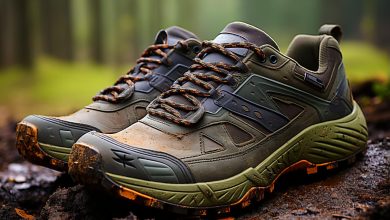Getting Started With Trail Running: Essential Tips for Beginners

If you’re ready to hit the trails and experience the exhilaration of trail running, then this article is for you. Lace up your shoes and get ready to explore nature’s playground with these essential tips for beginners.
Discover how to:
– Choose the right trail
– Gear up with the necessary equipment
– Prepare your body for the challenges ahead
– Stay safe on the trails
– Build endurance as you progress in your trail running journey.
Get ready to embrace the thrill of trail running like a seasoned pro.
Choosing the Right Trail

When choosing the right trail, it’s important to consider the difficulty level and terrain. As a beginner trail runner, you want to start with trails that are not too challenging but still offer a bit of variety in terms of elevation and obstacles. This will allow you to gradually build your skills and endurance without overwhelming yourself.
One important aspect to consider when hitting the trails is your choice of trail shoes. Unlike regular running shoes, trail shoes are specifically designed to provide better traction on uneven surfaces and protect your feet from rocks, roots, and other hazards commonly found on trails. Look for shoes that have aggressive tread patterns and durable soles for maximum grip and stability.
To find local trail options, you can start by researching online or asking fellow runners for recommendations. Local running clubs or outdoor stores often have information about popular trails in the area as well. It’s also a good idea to check out maps or apps that specialize in mapping out nearby trails, which can provide valuable details like distance, elevation gain/loss, and any potential hazards along the way.
Essential Gear and Equipment

To make the most of your trail running experience, you’ll need some key gear and equipment. The right gear can make all the difference in keeping you comfortable, safe, and prepared for any challenges you may encounter on the trails. Two essential items to invest in are a good pair of trail running shoes and a hydration pack.
Trail running shoes are specifically designed to provide better traction on uneven terrain and protect your feet from rocks, roots, and other obstacles. Look for shoes with durable outsoles, supportive cushioning, and breathable uppers. It’s important to find a shoe that fits well and suits your individual needs.
A hydration pack is crucial for staying hydrated during long runs on the trails. These packs typically feature a bladder or water bottles that allow you to conveniently carry water or sports drinks without having to stop at every water source along the way. Look for a pack that is lightweight, adjustable, and has enough storage space for essentials like snacks, sunscreen, and extra layers.
Table:
| Essential Gear | Features | Benefits |
|---|---|---|
| Trail Running Shoes | Durable outsoles Supportive cushioning Breathable uppers |
Better traction Protection from obstacles Comfort |
| Hydration Packs | Lightweight Adjustable fit Adequate storage space |
Convenient hydration No need to stop for water sources Easily carry essentials |
Preparing Your Body for Trail Running

Before hitting the trails, make sure you’re properly conditioning your body for trail running by incorporating strength training exercises into your fitness routine. Strength training is essential for preventing injuries and improving overall performance on the trails.
By strengthening your muscles, tendons, and ligaments, you can better handle the uneven terrain and challenging uphill climbs that are common in trail running.
To prevent injuries, focus on exercises that target the specific muscle groups used in trail running. Squats and lunges are great for building leg strength, while planks and push-ups help strengthen your core and upper body. It’s also important to include exercises that improve balance and stability, such as single-leg stands or Bosu ball workouts.
In addition to strength training, proper nutrition plays a crucial role in preparing your body for trail running. Fueling your body with the right nutrients will provide energy for those long runs while aiding in recovery afterward. Focus on consuming a balanced diet rich in carbohydrates, protein, healthy fats, vitamins, and minerals. Hydration is also key—make sure to drink enough water before, during, and after each run.
Safety Tips for Trail Running Beginners

While trail running, it’s important for beginners to prioritize safety and take precautionary measures. Injury prevention should be your top concern as you embark on this exhilarating outdoor activity.
First and foremost, invest in a good pair of trail running shoes that provide ample support and traction to navigate uneven terrains. This will help reduce the risk of ankle sprains or other foot-related injuries.
Additionally, always warm up before hitting the trails to prepare your muscles for the demanding workout ahead.
Trail etiquette is another crucial aspect to consider. Be mindful of other trail users, whether they are hikers, bikers, or fellow runners. Yielding the right of way and being respectful towards others will ensure a positive experience for everyone involved. Stay alert and aware of your surroundings at all times, especially when running on shared trails.
Transitioning into building endurance and progressing in trail running requires a gradual approach. Increase your mileage slowly over time to allow your body to adapt to the new demands. Incorporate strength training exercises targeting your legs and core to improve stability while tackling challenging terrains.
Building Endurance and Progressing in Trail Running

As you continue your trail running journey, gradually increase your mileage to build endurance and challenge yourself on more demanding terrains. Building endurance is essential for improving speed and overall performance in trail running.
Here are four tips to help you improve your endurance and progress in trail running:
1. Increase Mileage Gradually: Start by adding an extra mile or two to your runs each week. This gradual increase will allow your body to adapt and prevent injuries.
2. Incorporate Hill Training: Hills are a great way to improve strength and stamina. Include hill repeats or find hilly routes to challenge yourself.
3. Interval Training: Incorporate interval workouts into your training routine. These short bursts of high-intensity exercise followed by recovery periods will help improve speed and cardiovascular fitness.
4. Nutrition for Trail Running: Fueling properly is crucial for maintaining energy levels during long runs. Prioritize complex carbohydrates, lean proteins, and healthy fats in your diet to provide sustained energy throughout your runs.
Conclusion
Congratulations! You’ve reached the end of this informative journey on trail running. By now, you’re well-equipped with essential tips and tricks to kickstart your trail running adventure.
Remember, finding the perfect trail is like searching for a hidden treasure – it’s all about exploration and discovery.
As you gear up with the right equipment and prepare your body for the challenges ahead, always prioritize safety.
And don’t forget, building endurance takes time; so be patient and enjoy every step of this ironically enjoyable and rewarding experience.
Happy trails!






